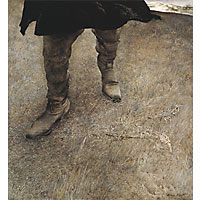
Andrew Wyeth‘s 70-year retrospective at the Philadelphia Museum of Art raises the issue of the great divide between what the public likes and what art insiders like-rarely the same thing.
Paintings like Christina’s World (not in the show, by the way, because it’s deemed too fragile to travel) are universally admired by the general public. These same paintings are scorned by many art insiders who feel Wyeth’s vision of an idealized rural America is faux, a kind of Ralph Lauren boutique art that implies good taste and money.
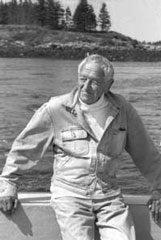
Wyeth, 89, is a public artist in spite of himself. Home-schooled and apprenticed to his famous artist father N.C. Wyeth, the artist is a solitary duck who grew up in a compound, sheltered from the outer world and close to the land. The land, the compound and its people are the only things he paints. Yet this intense private vision has been stripped down to some universal core that transcends the personal. The spare affect resulted from advice Wyeth took from his wife Betsy, who also encouraged him to lose the flashy brushstrokes and bright colors. Mrs. Wyeth has managed the artist’s career since the early days. She obviously has good instincts.
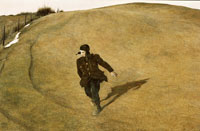
Here’s what I like: The artist is a virtuoso with his chosen media, egg tempera. He makes it look easy. In spite of the nostalgia (and there’s plenty), the images are humanist in nature. Wyeth’s world is full of solitary humans and animals. You can see the artist struggling with his own loneliness and humanity. Wyeth’s portraits are sensitive and beautiful. And the quality of light and stillness is very fine. His portrayal of the land is amazing. The earth is a character. In picture after picture the land heaves up behind the humans and all but swallows them.
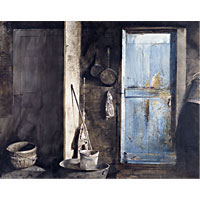
Here are the minuses: The paintings, especially the interiors, have a puritanical and chilly streak. Works that seem to praise barrenness, hard work and lack of comfort are judgmental. The overall affect of a romantic longing for a simpler time is unhealthy. And Wyeth’s fascination with death-Winter (1946), Night Sleeper (1979) Adrift (1982) and many others-is poetic clap trap. Finally, the denuding of bright color in favor of a stripped-down ocher-heavy palette is simply an artistic device that creates a signature, a style, a brand. It’s about selling, and it’s joyless.
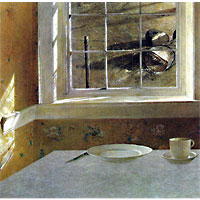
The public is hungry for an art vision, and while I object to the nostalgia trip Wyeth embodies, I love that people connect with any art and any artist at a time when most art has climbed into a bunker and left the public behind.
This show, with more than 100 works on view, gives Wyeth’s vision the serious look it deserves. Art insiders–you know who you are–check it out.
“Andrew Wyeth: Memory and Magic”
Through July 16, 2006. $20. Philadelphia Museum of Art, 26th St. and the Pkwy. 215.235.7469.









